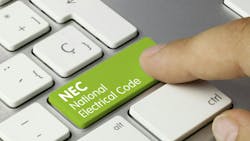Understanding General Requirements of the NEC, Part 3
Article 110 of the NEC provides general requirements for all installations. One of those requirements is that the conductors and equipment that are permitted or required by the NEC are acceptable only if approved [Sec. 110.2]. But what does “approved” mean? It means acceptable to the authority having jurisdiction [Art. 100]. The authority having jurisdiction is often referred to by the acronym "AHJ." So what exactly is it?
The AHJ is “…the organization, office, or individual responsible for enforcing the requirements of a code or standard, or for approving equipment, materials, an installation, or a procedure” [Art. 100].
The fine print note below the Art. 100 definition goes on to explain that jurisdictions and approval agencies vary, as do their responsibilities. It goes on to list the various bodies that may have jurisdiction when public safety is concerned, such as the electrical inspector. It also says that for insurance purposes, the AHJ might be (among others) the insurance company inspection department. And in many circumstances it may be (among others) the agent of the property owner.
So to know if the conductors and equipment are “approved,” you must know which AHJ or AHJs your installation is under the auspices of. For electrical work in production plants and similar, it’s usually a combination of entities, including the electrical inspector (representing the state) and the plant engineer or facility manager (representing the property owner).
What do these entities consider when deciding if something is acceptable? It should come as no surprise that they don’t want counterfeit products, such as fake breakers that have a badly done imitation of a major brand’s logo on them. So your first line of defense is to buy all of your electrical products from a reputable electrical supplier. This includes raceway, fittings, enclosures, couplings, conductors, circuit breakers, and motors. You might buy large items such as switchgear directly from a manufacturer, but again, it should be a reputable firm. Every seasoned project manager, buyer, and estimator knows who those firms are.
They have other concerns, as well. The gist of those is they want you to correctly install the correct materials and equipment for the application. Just because something is approved in one circumstance doesn’t mean it’s approved in another. This is why the Chapter 3 Articles list permitted and non-permitted uses.
Some other tips to ensure acceptability:
- Don’t violate the item’s listing by modifying it.
- No “off label” uses. That means don’t use EMT fittings with conduit, pipe fittings in an electrical system, etc.
- Use the correct size for the application.
- Observe the permitted uses (Sec. X.10 of any Chapter 3 Article) and nonpermitted uses (Sec. X.12 of any Chapter 3 Article).
- Follow established practices of installation and/or use. For example, if you decide to install a motor upside down (drain plug facing up), don’t expect an inspector to be happy about it.
Generally, you will meet the “approved” requirement if you source your materials and equipment from reputable suppliers and then install them as they are intended to be installed and use them only for the uses for which they are permitted to be used.
About the Author

Mark Lamendola
Mark is an expert in maintenance management, having racked up an impressive track record during his time working in the field. He also has extensive knowledge of, and practical expertise with, the National Electrical Code (NEC). Through his consulting business, he provides articles and training materials on electrical topics, specializing in making difficult subjects easy to understand and focusing on the practical aspects of electrical work.
Prior to starting his own business, Mark served as the Technical Editor on EC&M for six years, worked three years in nuclear maintenance, six years as a contract project engineer/project manager, three years as a systems engineer, and three years in plant maintenance management.
Mark earned an AAS degree from Rock Valley College, a BSEET from Columbia Pacific University, and an MBA from Lake Erie College. He’s also completed several related certifications over the years and even was formerly licensed as a Master Electrician. He is a Senior Member of the IEEE and past Chairman of the Kansas City Chapters of both the IEEE and the IEEE Computer Society. Mark also served as the program director for, a board member of, and webmaster of, the Midwest Chapter of the 7x24 Exchange. He has also held memberships with the following organizations: NETA, NFPA, International Association of Webmasters, and Institute of Certified Professional Managers.
